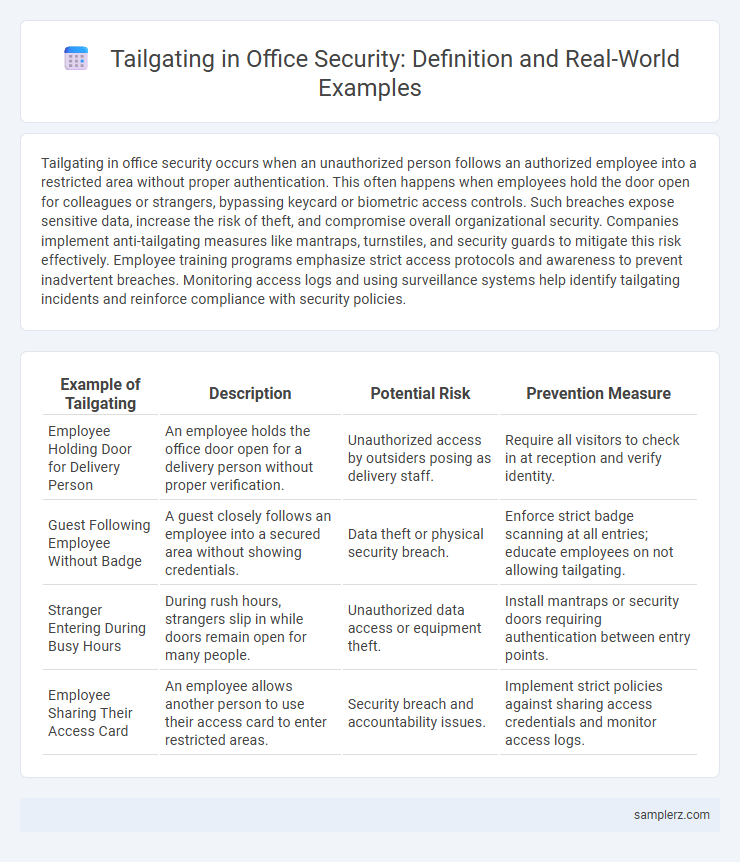Tailgating in office security occurs when an unauthorized person follows an authorized employee into a restricted area without proper authentication. This often happens when employees hold the door open for colleagues or strangers, bypassing keycard or biometric access controls. Such breaches expose sensitive data, increase the risk of theft, and compromise overall organizational security. Companies implement anti-tailgating measures like mantraps, turnstiles, and security guards to mitigate this risk effectively. Employee training programs emphasize strict access protocols and awareness to prevent inadvertent breaches. Monitoring access logs and using surveillance systems help identify tailgating incidents and reinforce compliance with security policies.
Table of Comparison
| Example of Tailgating | Description | Potential Risk | Prevention Measure |
|---|---|---|---|
| Employee Holding Door for Delivery Person | An employee holds the office door open for a delivery person without proper verification. | Unauthorized access by outsiders posing as delivery staff. | Require all visitors to check in at reception and verify identity. |
| Guest Following Employee Without Badge | A guest closely follows an employee into a secured area without showing credentials. | Data theft or physical security breach. | Enforce strict badge scanning at all entries; educate employees on not allowing tailgating. |
| Stranger Entering During Busy Hours | During rush hours, strangers slip in while doors remain open for many people. | Unauthorized data access or equipment theft. | Install mantraps or security doors requiring authentication between entry points. |
| Employee Sharing Their Access Card | An employee allows another person to use their access card to enter restricted areas. | Security breach and accountability issues. | Implement strict policies against sharing access credentials and monitor access logs. |
Common Office Tailgating Scenarios
Common office tailgating scenarios include employees holding doors open for coworkers without verifying identity, allowing unauthorized individuals to enter secure areas. Delivery personnel or visitors often follow employees closely without using access badges, bypassing security protocols. This behavior increases the risk of data breaches and physical security threats by enabling intruders to access restricted zones unnoticed.
Real-Life Tailgating Incidents in Workplaces
Real-life tailgating incidents in workplaces often involve unauthorized individuals closely following employees through secured entry points without valid access credentials. These breaches expose companies to data theft, physical security risks, and compromised employee safety. Implementing strict access control measures and employee awareness training significantly reduces the frequency of tailgating in office environments.
How Unauthorized Visitors Exploit Office Entry Points
Unauthorized visitors exploit office entry points by closely following authorized personnel through secure doors without proper authentication, commonly known as tailgating. These intruders often take advantage of busy entryways during shift changes or when employees hold doors open for others, bypassing badge scanners or biometric systems. Tailgating poses significant security risks, potentially allowing access to sensitive areas, corporate data breaches, or physical asset theft.
Employees Unknowingly Facilitating Tailgating
Employees unknowingly facilitate tailgating when they hold doors open for colleagues or visitors without verifying credentials, creating security vulnerabilities in office environments. This behavioral lapse allows unauthorized individuals to gain access to restricted areas, increasing the risk of data breaches and physical theft. Regular security training and strict access control policies are essential to mitigate the threat posed by inadvertent tailgating in the workplace.
Social Engineering Techniques Used in Office Tailgating
Office tailgating exploits social engineering techniques such as exploiting politeness norms to gain unauthorized access by closely following authorized personnel through secure doors. Attackers often use pretexting, pretending to be employees or delivery personnel, to reduce suspicion and manipulate employees into holding doors open. This manipulation leverages human trust and lack of vigilance in busy office environments to bypass access controls and compromise security.
Impact of Tailgating on Corporate Security
Tailgating in an office setting allows unauthorized individuals to bypass secure access points by closely following an authorized employee, significantly increasing the risk of data breaches and physical theft. This security lapse compromises sensitive corporate information, exposes critical infrastructure to sabotage, and undermines employee safety. The financial losses and reputational damage resulting from tailgating incidents highlight the urgent need for stringent access control measures and employee awareness training.
Notorious Office Tailgating Breach Cases
Notorious office tailgating breach cases include the 2019 Capital One data center intrusion where an attacker followed an employee into a secured facility, bypassing card readers. Another example is the 2017 Tesla office breach when a former contractor gained unauthorized entry by tailgating staff, leading to the theft of sensitive prototypes. These incidents highlight the critical need for rigorous access control measures and employee security awareness training.
Tailgating During Shift Changes and Rush Hours
Tailgating during shift changes and rush hours significantly increases security risks as unauthorized individuals exploit crowded entry points to gain access to secure office areas without proper credentials. These peak times create chaotic environments where security personnel may struggle to monitor each person, allowing intruders to follow closely behind authorized employees. Implementing measures such as turnstiles, biometric access controls, and employee awareness training helps mitigate the threat of tailgating during these vulnerable periods.
Surveillance Footage: Visual Examples of Tailgating
Surveillance footage often reveals tailgating incidents in office environments where unauthorized individuals closely follow employees through secured doors without proper authentication. These visual examples highlight the importance of vigilant access control systems and employee awareness to prevent security breaches. Continuous monitoring of entry points via CCTV cameras enhances detection and deterrence of tailgating attempts.
Case Studies of Tailgating in High-Security Offices
High-security offices report numerous tailgating incidents where unauthorized individuals follow employees through secure access points, bypassing biometric or card-based authentication systems. Case studies reveal attackers often exploit human factors, such as holding doors open or posing as delivery personnel, leading to significant data breaches and theft of proprietary information. Implementing multifactor authentication and rigorous employee training has proven essential in mitigating these security vulnerabilities in corporate environments.

example of tailgating in office Infographic
 samplerz.com
samplerz.com